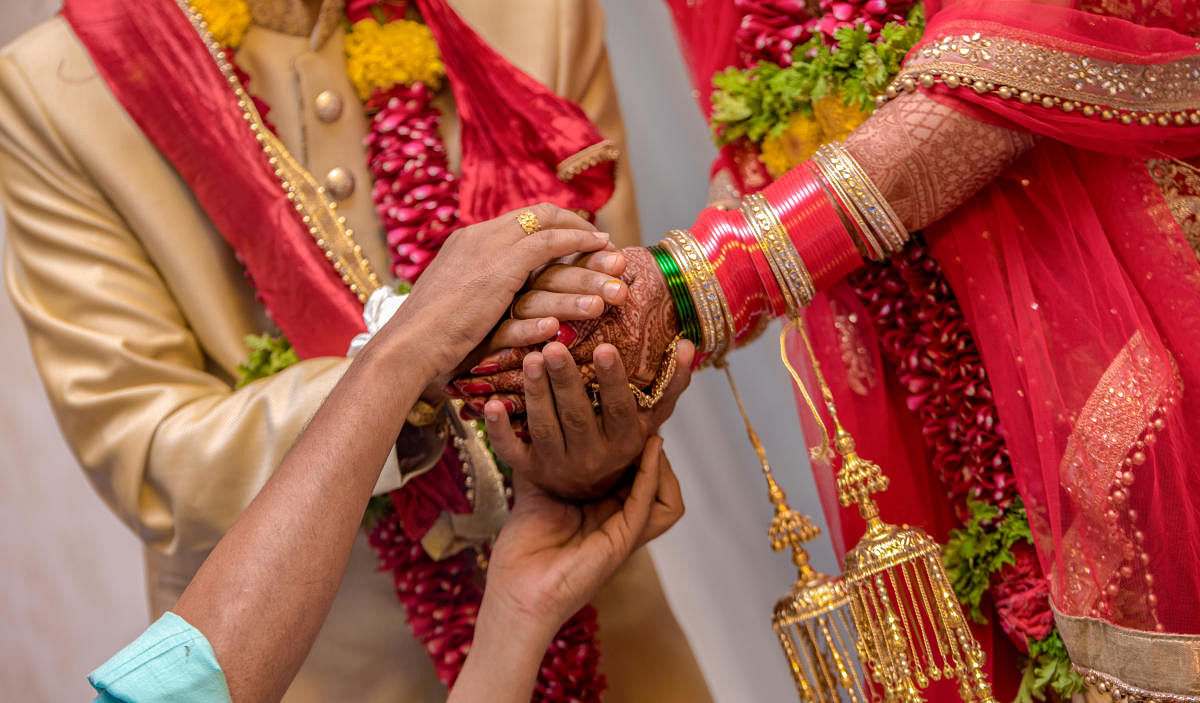
Two schemes introduced by the Karnataka State Brahmin Development Board to help economically backward brides could end up with unintended consequences, sociologists say.
The first scheme, Arundathi, provides a grant of Rs 25,000, while the second, Maitreyi, provides Rs 3 lakh over three years to any Brahmin girl marrying an economically backward Brahmin priest.
Malavika Binny, professor who specialises in caste and gender history, says the schemes reinforce caste and promote endogamy, the practice of marrying within one’s community. “One must remember that B R Ambedkar had clearly argued that ending endogamy is the only way to annihilate caste,” she says.
Promoting endogamy among Brahmins is based on age-old considerations of caste purity and pollution, which are linked to untouchability, says Vasudha MC, who teaches sociology at Jyoti Nivas College.
Munichowdappa N, professor of public administration with a special interest in Dalit and women empowerment, says welfare schemes should be geared towards the uplift of the socially disadvantaged.
"Providing it to socially stronger sections under the guise of economic backwardness is an appeasement tactic," he says.
He notes that a family that has a gross annual income below Rs 8 lakh is denoted as 'economically weaker'. “The classification in itself is problematic,” he says.
But what about Shaadi Bhagya, a scheme introduced by the erstwhile Siddaramaiah government for women from the minorities? The current BJP government put an end to it, saying it was an appeasement tactic.
“Schemes like that don’t make it mandatory for a woman to marry within the community, which changes the conversation around it, at least in terms of caste,” says Munichowdappa.
However, he sees little value in such schemes. “Marriage is not a solution to poverty. Schemes that want to better the economic condition of an individual must focus on education and employment,” he says.
Abusive relationships and a total lack of choice in marriage partners might be among the unintended consequences, warns Vasudha. She apprehends the three-year bond in the Maitreyi scheme might force women to remain in bad marriages. Additionally, these schemes are only open to women who have never been married before.
Taxpayer money
Vasudha notes that the board has access to an annual budget of Rs 25 crore and is planning to seek Rs 200 crore in the next budget. The money can be put to good use on health and education and not on incentivising marriages, she suggests.
Malavika is sceptical about the legality of the scheme. “Can the state ask a couple to stay married for three years?” she wonders. The schemes restrict the scope for choosing a spouse, concludes Vasudha.
Two schemes
Maitreyi: It provides monetary assistance of up to Rs 3 lakh to Brahmin girls who marry economically backward Brahmin priests. The money is in a bond and stipulates that the couple remain married for three years. Rs 1 lakh is given at the end of every year.
Arundhati: Provides a grant of Rs 25,000 to economically backward brides. It should be her first marriage and the couple must give an undertaking that they will stay married for a stipulated amount of time, which has not been specified.
Just a small incentive, says board director
Vineeth Bhat, advocate and director of the Brahmin Development Board, says the schemes are not introduced with the intention of promoting endogamy.
“The intention is to help the poor in the community. It is left to the individuals whether they want to marry or not, and who to marry, but the board has certain constraints. Other caste boards will formulate such schemes for their communities," he says.
Schemes already exist to promote health and education, he says when asked about why marriage is being included in the scheme.
"The state is not promoting marriage. Some people in certain professions need funds to incentivise a relationship. It is an individual choice. This scheme is to ensure they have a happy marriage," he says.
No one will get married just to get the monetary incentive, he adds. "A small incentive should not be criticised with complex theories," he told Metrolife.